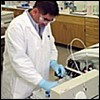 铅中毒的原因、临床表现及预
铅中毒的原因、临床表现及预 放假了,这些东西容易导致孩
放假了,这些东西容易导致孩 [图文]全美约3000个地区儿童
[图文]全美约3000个地区儿童 [图文]六问儿童血铅超标,,铅
[图文]六问儿童血铅超标,,铅 [图文]我国儿童铅中毒防治并
[图文]我国儿童铅中毒防治并 [图文]铅污染防治技术及政策
[图文]铅污染防治技术及政策 [图文]我会专家赴晋城开展儿
[图文]我会专家赴晋城开展儿 保护孩子远离铅污染,防止铅
保护孩子远离铅污染,防止铅 [组图]傅松涛教授接受《新京
[组图]傅松涛教授接受《新京 六味地黄丸铅超标论文作者表
六味地黄丸铅超标论文作者表 [组图]小心铅中毒会夺去巴哥
[组图]小心铅中毒会夺去巴哥 女子铅中毒 整月呕吐腹痛
女子铅中毒 整月呕吐腹痛 铅中毒的原因、临床表现及预
铅中毒的原因、临床表现及预 放假了,这些东西容易导致孩
放假了,这些东西容易导致孩 防治铅中毒:“蒜”你有本事
防治铅中毒:“蒜”你有本事 工业园排污致当地儿童铅中毒
工业园排污致当地儿童铅中毒 这里还有铅中毒儿童
这里还有铅中毒儿童 [图文]全美约3000个地区儿童
[图文]全美约3000个地区儿童 [组图]中国的集体铅中毒事件
[组图]中国的集体铅中毒事件 关注铅中毒从培养绿色消费方
关注铅中毒从培养绿色消费方 Exposure to Lead
Exposure to Lead
Biomonitoring has figured prominently in helping states and the nation address health policy and regulatory concerns. One of the most powerful examples of the value of biomonitoring on a national level involves the common metal, lead. Exposure to even small amounts of lead can cause serious, even fatal, consequences, especially among children. Public health officials have been concerned about lead exposure (particularly from lead-based paint and leaded gasoline) for close to a century, but efforts to reduce that exposure substantially, particularly mid-20th century, were largely unsuccessful.
Although deaths from lead exposure are now extremely rare in the United States, even low levels of lead in children can cause harm. In 1960, CDC considered lead poisoning as a level of 60 micrograms of lead per deciliter of blood (mg/dL). As scientists learned more about lead's harmful effects, CDC revised downward its definition of lead poisoning. By 1990, scientific studies showed harmful health effects associated with lower blood lead levels. These findings led CDC to lower the blood lead level of concern to 10 mg/dL. Clearly, the toxicity of lead has not changed, but advances in biomonitoring technology have allowed CDC and others to measure lower and lower blood lead levels and then to correlate those levels with harmful health effects in people. In the early 1980s, biomonitoring was instrumental in helping policy makers decide to remove lead from gasoline. From 1976 through 1980, lead levels in gasoline had declined substantially. Lead was being reduced in gasoline, not because of its documented adverse health effects, but because it interfered with the operation of catalytic converters in automobiles. Nonetheless, in 1980, the U.S. Environmental Protection Agency (EPA) considered regulatory changes that would have increased the amount of lead in gasoline on the basis of information available at that time which indicated that lead in gasoline contributed little to the amount of lead in people. However, from 1976 through 1980, CDC conducted its second National Health and Nutrition Examination Survey (NHANES II) and showed that declines in actual blood lead levels measured in people matched declines in levels of lead in gasoline. This critical finding was the one key factor that caused EPA to reverse its proposed policy and to remove lead from gasoline more rapidly.
In the early 1980s, biomonitoring was instrumental in helping policy makers decide to remove lead from gasoline. From 1976 through 1980, lead levels in gasoline had declined substantially. Lead was being reduced in gasoline, not because of its documented adverse health effects, but because it interfered with the operation of catalytic converters in automobiles. Nonetheless, in 1980, the U.S. Environmental Protection Agency (EPA) considered regulatory changes that would have increased the amount of lead in gasoline on the basis of information available at that time which indicated that lead in gasoline contributed little to the amount of lead in people. However, from 1976 through 1980, CDC conducted its second National Health and Nutrition Examination Survey (NHANES II) and showed that declines in actual blood lead levels measured in people matched declines in levels of lead in gasoline. This critical finding was the one key factor that caused EPA to reverse its proposed policy and to remove lead from gasoline more rapidly. As gasoline lead declined, subsequent national surveys continued to show declining blood lead levels, which, by 2000, had fallen to 2.23 ug/dL among children aged 1-5 years. Today, the greatest sources of exposure to lead are lead-based paint and lead-contaminated dust. U.S. children who live in cities, are from lower socioeconomic groups, or are immigrants to this country, have a higher prevalence than other children of elevated blood lead levels. Children whose blood lead levels are greater than 10 ug/dL are at increased risk for learning and behavioral problems.
As gasoline lead declined, subsequent national surveys continued to show declining blood lead levels, which, by 2000, had fallen to 2.23 ug/dL among children aged 1-5 years. Today, the greatest sources of exposure to lead are lead-based paint and lead-contaminated dust. U.S. children who live in cities, are from lower socioeconomic groups, or are immigrants to this country, have a higher prevalence than other children of elevated blood lead levels. Children whose blood lead levels are greater than 10 ug/dL are at increased risk for learning and behavioral problems.